Introduction
Navigating the intricate landscape of Autism Spectrum Disorder (ASD) and gender dysphoria presents unique challenges and opportunities for understanding. With a growing body of research revealing the significant overlap between these identities, it becomes crucial to explore the ways in which autism can influence individuals’ experiences of gender. Autistic individuals, particularly those assigned female at birth, often face societal misunderstandings that complicate their journey of self-discovery and acceptance.
This article delves into the nuanced relationship between ASD and gender identity, highlighting the importance of tailored support systems that recognize both neurodiversity and gender diversity. By fostering inclusive environments, the well-being of individuals at this intersection can be significantly enhanced, paving the way for empowerment and self-advocacy.
Defining Autism Spectrum Disorder (ASD) and Gender Dysphoria
Autism Spectrum Disorder (ASD) is a complex developmental condition defined by challenges in communication, social interactions, and patterns of behavior that may be repetitive or restricted. The spectrum nature of ASD means that people can experience a wide array of symptoms and abilities, making each person's journey unique. Recent discussions highlight the growing recognition of neurodiversity, which frames autism not merely as a clinical diagnosis but as a differing neurological makeup that can lead to both social and personal challenges. For instance, misunderstandings and stigmatization often accompany the lived experiences of those on the autism spectrum, underscoring the importance of tailored support in areas such as education, health care, and social belonging.
In contrast, gender dysphoria describes the psychological distress stemming from a mismatch between a person's experienced or expressed identity and the sex assigned at birth. This experience can be especially evident among people on the spectrum, with research suggesting that a notable segment of those pursuing transition services also display characteristics linked to the condition. Data from the National Gender Service reveals that over 50% of people assessed in 2019 either had a pre-existing autism diagnosis or displayed clear features of autism during evaluation.
This intersection between ASD and identity dysphoria highlights the need for nuanced understanding and support. Autistic people, particularly those designated female at birth (AFAB), may encounter distinct obstacles in self-development and health care access, requiring a comprehensive approach that acknowledges both their neurodivergent nature and their expression of gender. As the discussion around sex orientation continues to develop, it becomes essential to create spaces that affirm and assist the varied experiences of individuals experiencing both neurodiversity and identity conflict.
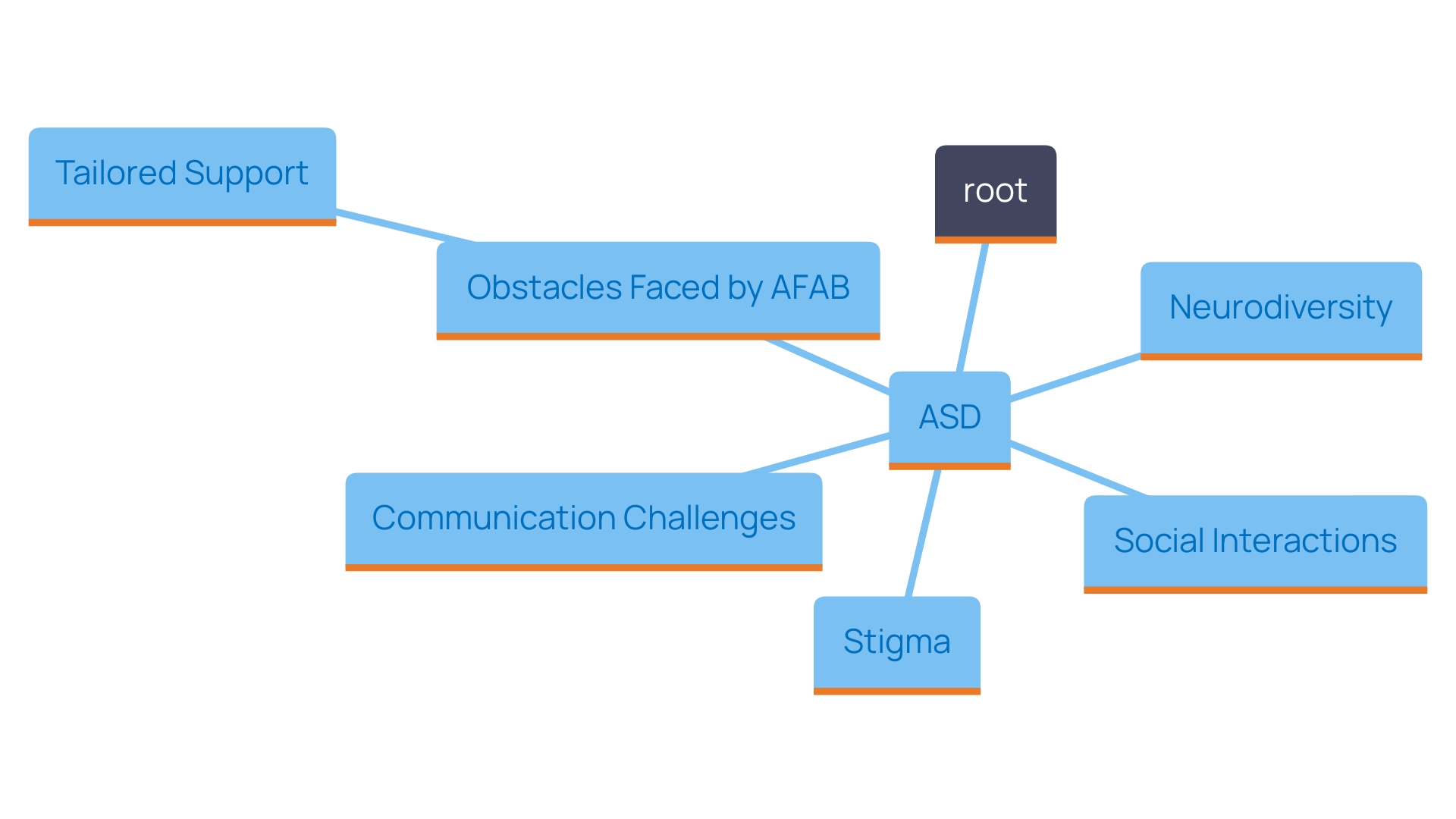
The Connection Between Autism and Gender Identity
Studies show that people on the spectrum may explore their sense of self in ways that vary greatly from those who are neurotypical. Numerous autistic people indicate encountering gender dysphoria, which highlights a distinct overlap between neurodiversity and gender identity. This phenomenon is well-documented, with studies revealing that approximately 34% of people assessed at the National Gender Service in 2019 either had a pre-existing diagnosis or exhibited clear features of the condition. This number is on the rise, currently exceeding 50%, suggesting that the prevalence of the condition in the transgender population is increasingly acknowledged.
The connection between neurodevelopmental conditions and expressions of self can be shaped by variations in social understanding, which impacts how people perceive and communicate their roles. For many autistic people, gender expression may be adaptable or less aligned with societal expectations. The neurodiversity movement encourages autistic people to accept themselves, seeing autism as a fundamental aspect of their being. This viewpoint emphasizes the significance of customized assistance for autistic people assigned female at birth (AFAB) in fields such as education, personal development, and health care.
Grasping the intricacies of identity in autistic people demands a subtle method, acknowledging that conventional roles and stereotypes might not be relevant. As Lynn Perry, a developmental psychology researcher, emphasizes, it is essential to address the unique needs of autistic people by incorporating both identity-first and person-first language to promote inclusivity and respect.
Furthermore, it is essential to distinguish between biological sex and identity, as they include various characteristics that can affect the experience of a person with autism. For example, designated sex at birth, like AFAB or assigned male at birth (AMAB), plays a significant role in shaping societal expectations and personal self-conception, yet it may not always correspond with one’s sense of self. Therefore, a nurturing atmosphere that acknowledges and appreciates these experiences is essential for the welfare of autistic people dealing with dysphoria related to their identity.
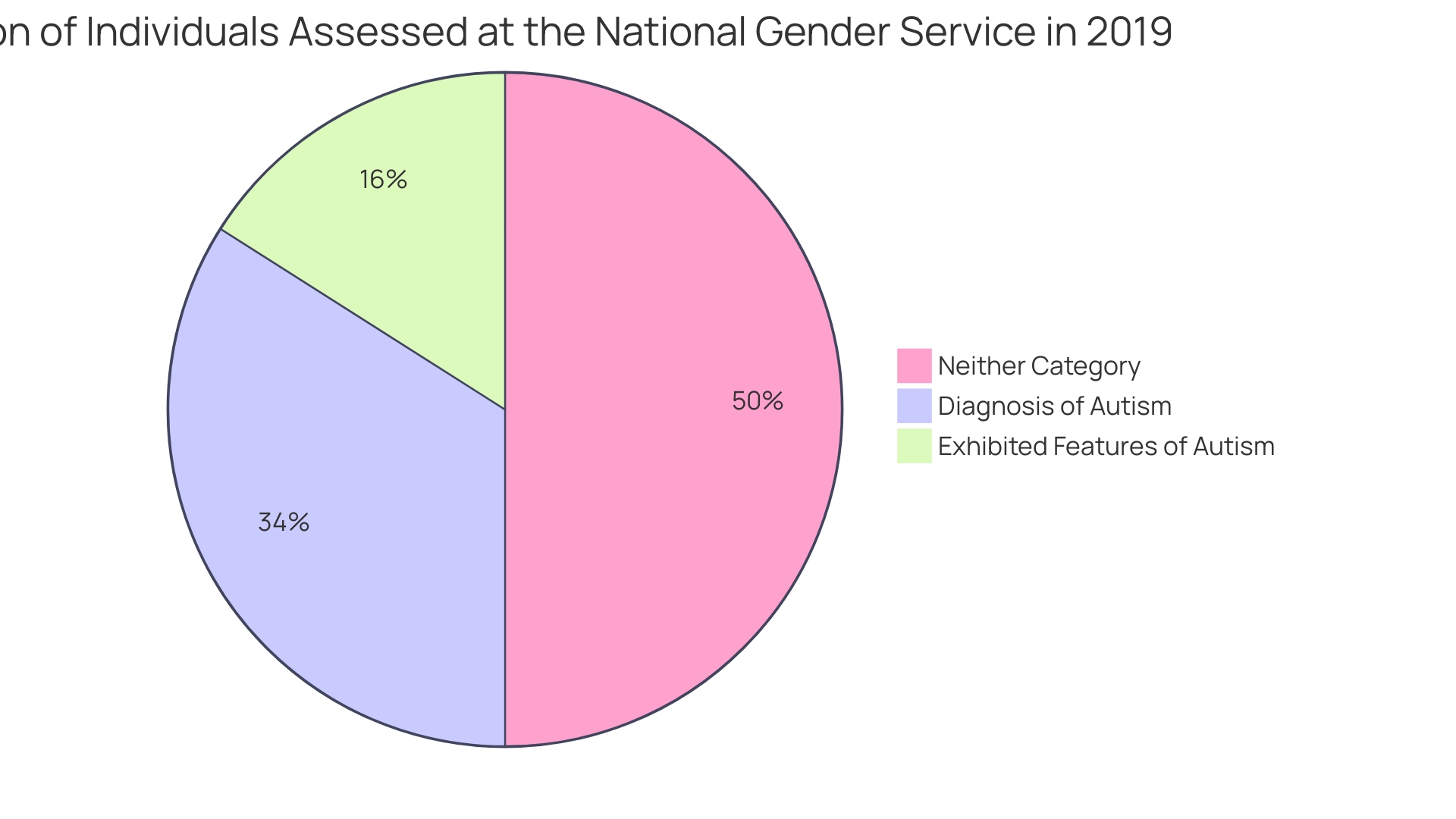
Research Findings on Autism and Gender Dysphoria
New studies emphasize a substantial link between neurodevelopmental differences and identity, showing that those on the spectrum are markedly more inclined to identify as transgender or non-binary compared to their neurotypical counterparts. This connection raises vital questions regarding the factors that contribute to a higher prevalence of identity issues among those with developmental spectrum disorder (ASD).
For example, information from the National Gender Service shows that in 2019, 10% of people undergoing initial assessments had a pre-existing diagnosis of a developmental disorder, and an additional 24% exhibited clinical characteristics of this condition during evaluations. This indicates that more than 34% of those seeking gender-related support may have autism, a figure that has recently increased to over 50%. Such statistics highlight the necessity for tailored support systems that address the unique needs of autistic people, particularly those assigned female at birth (AFAB).
The neurodiversity paradigm encourages autistic individuals to embrace their neurodivergence as a fundamental aspect of who they are. Grasping this perspective not only promotes enhanced self-acceptance but also highlights the significance of recognizing how these traits can influence an individual's experience of their personal roles. For many, this condition is more than just a clinical diagnosis; it is a crucial part of their self-conception and influences life decisions in various domains, such as education and career choices.
Additionally, the intricacies related to gender roles and neurodiversity encompass the societal and personal difficulties encountered by those on the spectrum. They often encounter societal misunderstanding and stigmatization, which can exacerbate feelings of isolation and dysphoria. This intersectionality emphasizes the necessity for inclusive practices in healthcare, education, and community environments that acknowledge both autistic experiences and variations in gender roles.
In general, the interaction between neurodiversity and gender incongruence emphasizes the need for heightened awareness and comprehension, ultimately supporting a more inclusive strategy to assist that affirms and elevates the experiences of neurodiverse people exploring their expression.
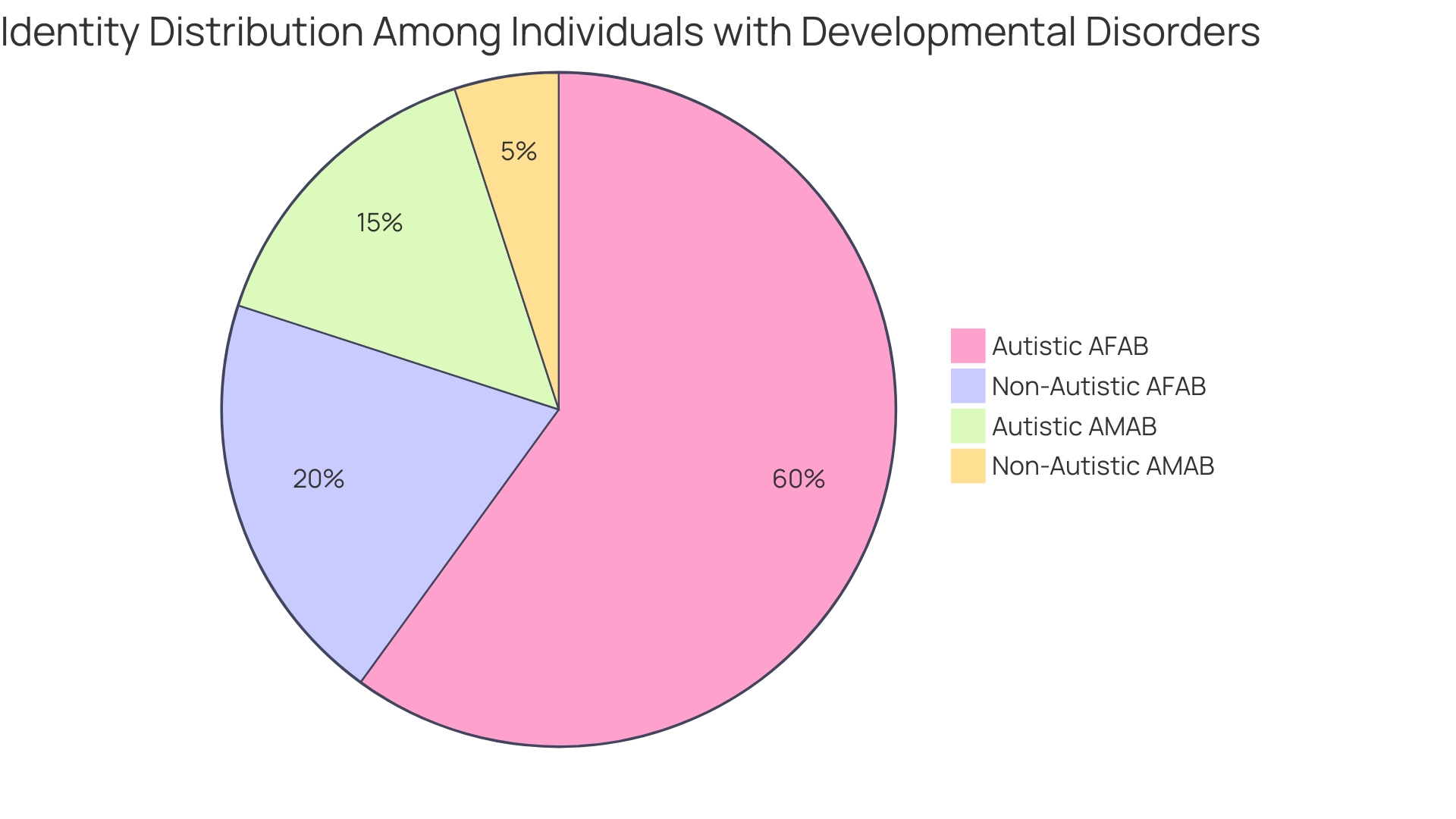
Key Factors Influencing the Relationship Between Autism and Gender Dysphoria
The connection between autism and sex variance is influenced by several elements, such as cognitive processing styles, social experiences, and the intricacies of self-concept development. People on the autism spectrum often traverse a society that does not accommodate their distinct viewpoints, which can complicate their comprehension of roles and social expectations. Studies show that numerous individuals create a distinct separation between sex and social roles; while sex is frequently characterized by biological traits, social roles include various functions and personal understandings. 'This distinction is essential, as it emphasizes that classifications that resonate with the lived experiences of transgender persons are often more beneficial and cognitively aligned with human understanding than traditional, sex-based definitions.'.
'Social marginalization plays a significant role in shaping how autistic people explore their gender sense of self.'. The pressures of conforming to societal norms can lead many to engage in social camouflage, where they may feel compelled to downplay or hide their true selves to fit in. This is particularly evident in cultures that emphasize conformity, such as Japan, where autistic people might face heightened mental health challenges due to the stress of pretending to be non-autistic. The intersection of social stigma and postponed diagnoses highlights the urgent requirement for customized support systems that validate and affirm the experiences of autistic persons, especially those who identify as transgender or non-binary.
Importantly, the neurodiversity approach motivates autistic people to accept their condition as a fundamental aspect of who they are. This perspective not only enhances self-acceptance but also fosters resilience and a sense of belonging. 'Autistic people, particularly those assigned female at birth (AFAB), should receive specialized support in various areas, including education, health care, and social integration.'. This nuanced understanding of self recognizes that this condition is not merely a clinical diagnosis but a vital aspect of self-definition that influences life choices, from careers to personal relationships.
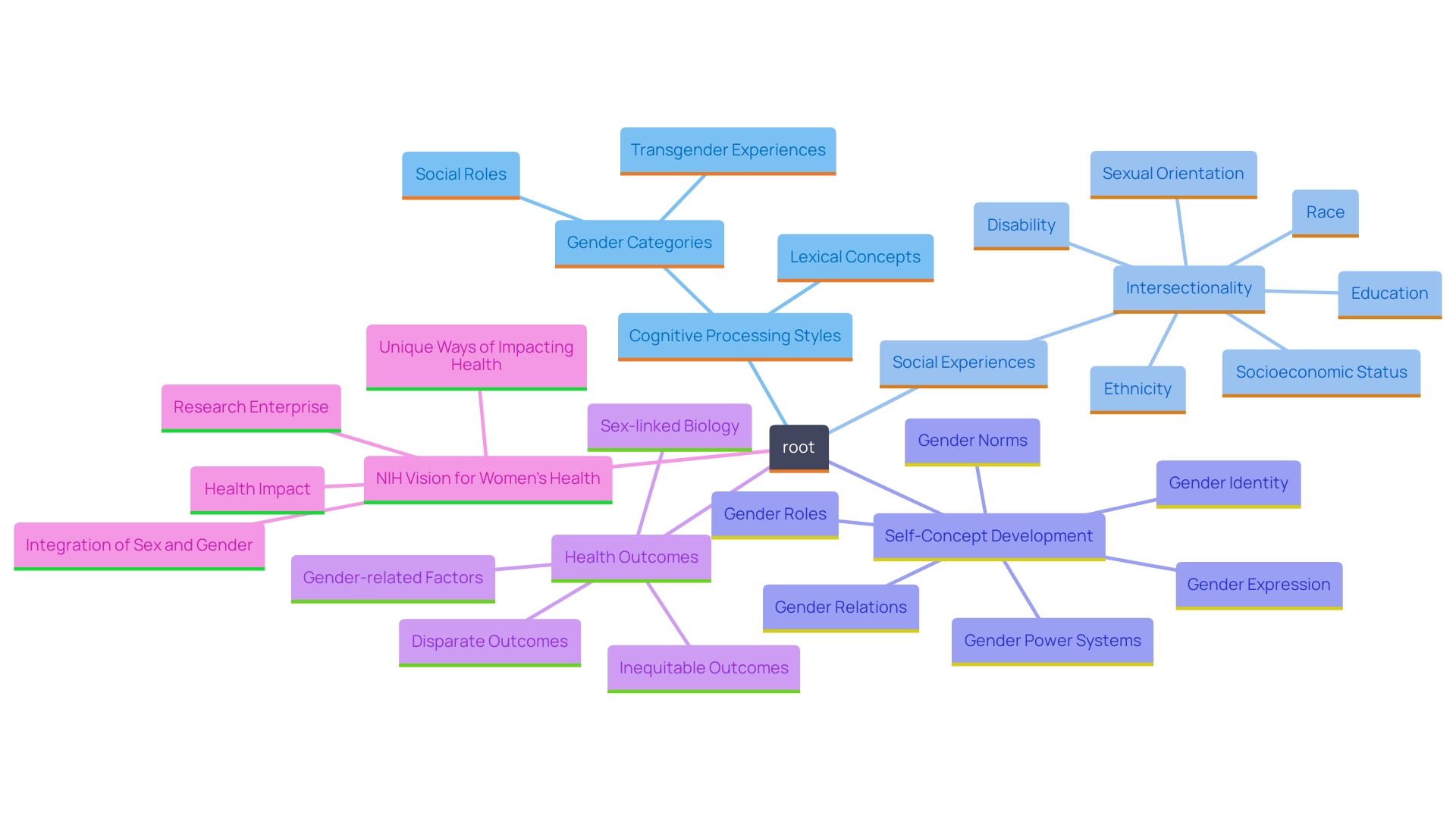
Impact of Autism on Experiencing and Expressing Gender Dysphoria
Navigating the intersection of autism and identity confusion presents unique challenges for individuals on the autism spectrum. 'Communication obstacles, frequently intrinsic to Autism Spectrum Disorder (ASD), can impede effective expression of emotions associated with roles and dysphoria.'. This difficulty is compounded by sensory sensitivities that may make certain expressions of identity uncomfortable. For example, an autistic individual may have difficulty wearing attire that conforms to social norms for their designated gender, resulting in discomfort and further complicating their experience of gender.
Tailored support is crucial for those who are assigned female at birth (AFAB) and identify as autistic. Recent insights emphasize that autistic AFAB persons require specialized resources in education, self-development, and healthcare, all while fostering a sense of belonging in social and professional contexts. As autism is increasingly acknowledged as a type of neurodivergence—functioning differently from neurotypical standards—comprehending the social and personal factors contributing to the experience of disability is essential.
Research also emphasizes that public self-awareness plays an important role in how autistic people interact with their sense of self. Many may resort to camouflaging behaviors, a phenomenon where people suppress their autistic traits to fit in socially. This can lead to misdiagnosis or underdiagnosis, particularly among females. 'Autistic AFAB persons often encounter societal pressures and stereotypes that further complicate their understanding and acceptance of their identity.'.
The complexity of sex and gender is further illustrated by the need to distinguish between sex-related factors, such as physiology and anatomy, and gender-related factors, which include societal stereotypes and role expectations. Using inclusive language, such as identity-first language—referring to individuals as 'autistic people'—reflects the lived experiences of those navigating these intersections. For many, this condition is not merely a medical classification but an essential aspect of who they are, requiring assistance that honors and affirms their distinct experiences.
In summary, acknowledging the multifaceted nature of autism and identity dysphoria is essential in providing effective support. By understanding these unique challenges, advocates and caregivers can better address the needs of those who are both autistic and exploring their sense of self.
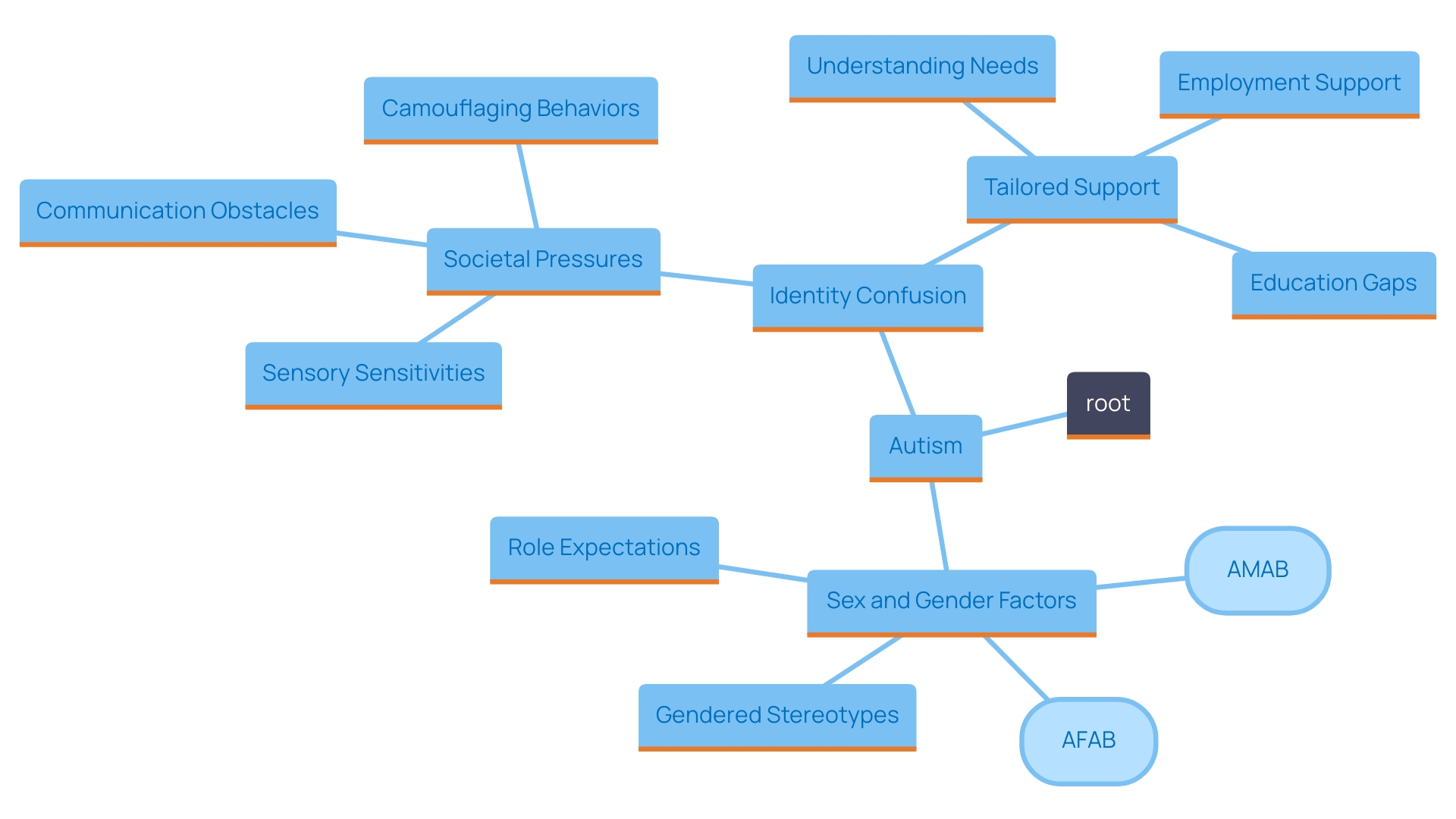
Challenges in Supporting Autistic Individuals with Gender Dysphoria
Supporting autistic people who experience gender dysphoria involves navigating a complex landscape of self-concept, societal perceptions, and available resources. Parents and caregivers often face the challenging task of finding personalized support that includes education, self-development, and healthcare needs specific to autistic AFAB (assigned female at birth) people. Research indicates that this condition is not merely a clinical diagnosis; it represents a unique identity intertwined with both social and individual experiences of neurodiversity. This understanding highlights the significance of perceiving this condition through a more inclusive perspective, steering clear of the stigmatizing implications frequently linked with conventional diagnostic language.
'Stigma and misunderstanding surrounding both autism and issues of identity can exacerbate feelings of isolation for those affected.'. For instance, societal stereotypes may misrepresent those with autism, often leading to misconceptions about their ability to understand or express gender identity. Recognizing this intersectionality is vital for creating a space where autistic people can flourish. As the growing acknowledgment of neurodiversity emphasizes, autistic people often face challenges from both social and medical viewpoints, necessitating thorough support systems.
Institutions and advocacy groups are striving to bridge this gap. 'Initiatives like the recent collaboration between Emirates and local neurodiversity groups aim to enhance experiences for neurodivergent travelers, demonstrating how tailored approaches can foster inclusivity.'. These efforts are a testament to the growing acknowledgment of the need for supportive environments that affirm the self-concepts of people with autism who may also identify as transgender or non-binary.
Open communication and education are vital components in dismantling stigma and misunderstanding. By creating avenues for dialogue and understanding, parents can help their children articulate their experiences and needs more effectively. This involves engaging with healthcare professionals and educators to ensure that support systems are aligned with the unique challenges these individuals face. As Stephan Scrofani, an expert in socio-emotional development for transgender youth, points out, tailored support is essential for fostering a sense of belonging and acceptance.
'The efforts of groups such as A4TE emphasize the significance of trans-led initiatives that concentrate on community-specific requirements, ensuring that all voices are acknowledged and valued in conversations about self-concept and support.'. By utilizing these resources, parents can enable their children to explore who they are with assurance, dismantling obstacles and promoting a more inclusive world.
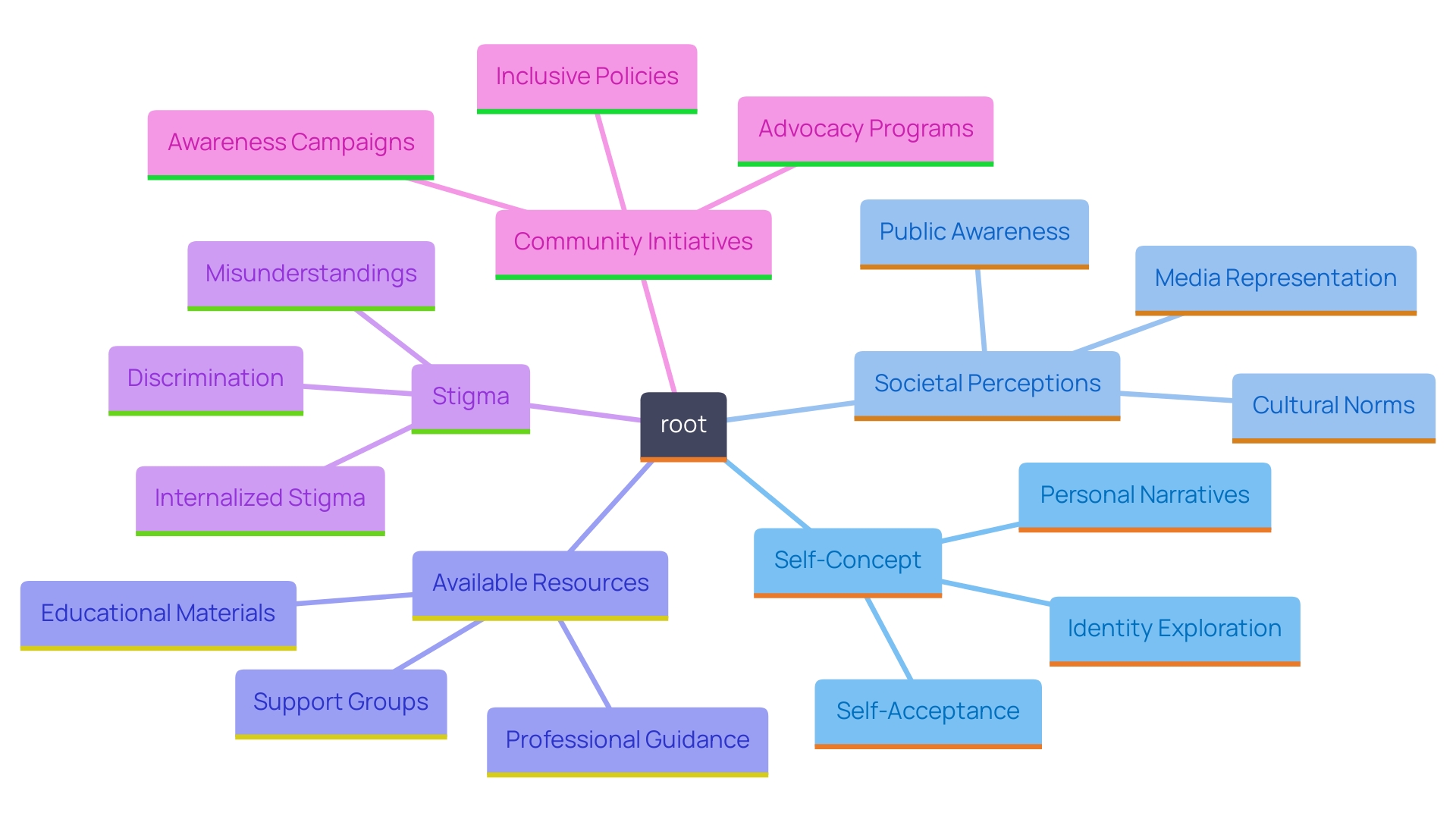
The Importance of Tailored Support and Interventions
Customized assistance is essential for autistic people dealing with gender dysphoria, as it recognizes the distinct relationship between autism and gender. Personalized therapy methods should be created to take into account both aspects, providing a thorough understanding of the emotional terrain these people experience. Creating safe spaces—whether in educational settings, healthcare environments, or community activities—encourages exploration and expression of their identities without fear of judgment or misunderstanding.
Collaborative efforts among parents, professionals, and support networks can significantly enhance the experience of those with autism. As Dr. David (Dan) R. Offord noted, the engaged and well-supported participation of children with disabilities in various life domains is a fundamental determinant of mental health. This emphasizes the significance of acknowledging both the unmet needs and the strengths that people contribute to their communities. For autistic youth, especially those facing co-occurring emotional and behavioral challenges, the risk of exclusion from meaningful social participation can lead to chronic stress. Consequently, it is essential to address these challenges through knowledgeable support systems that enable persons to accept their true selves while protecting their emotional and mental health.
Emerging evidence underscores the necessity of tailored support in personal development, health care, and fostering a sense of belonging. 'Autistic people assigned female at birth (AFAB) particularly benefit from approaches that respect their unique experiences, as this reflects a growing recognition of neurodiversity.'. Autism is increasingly viewed not just as a clinical diagnosis but as a crucial aspect of an individual, thus necessitating a shift in how support needs are defined. By moving away from traditional functioning labels and focusing instead on the specific support required, we can better address the lived experiences of these individuals. This holistic approach not only validates their identities but also promotes their overall well-being.
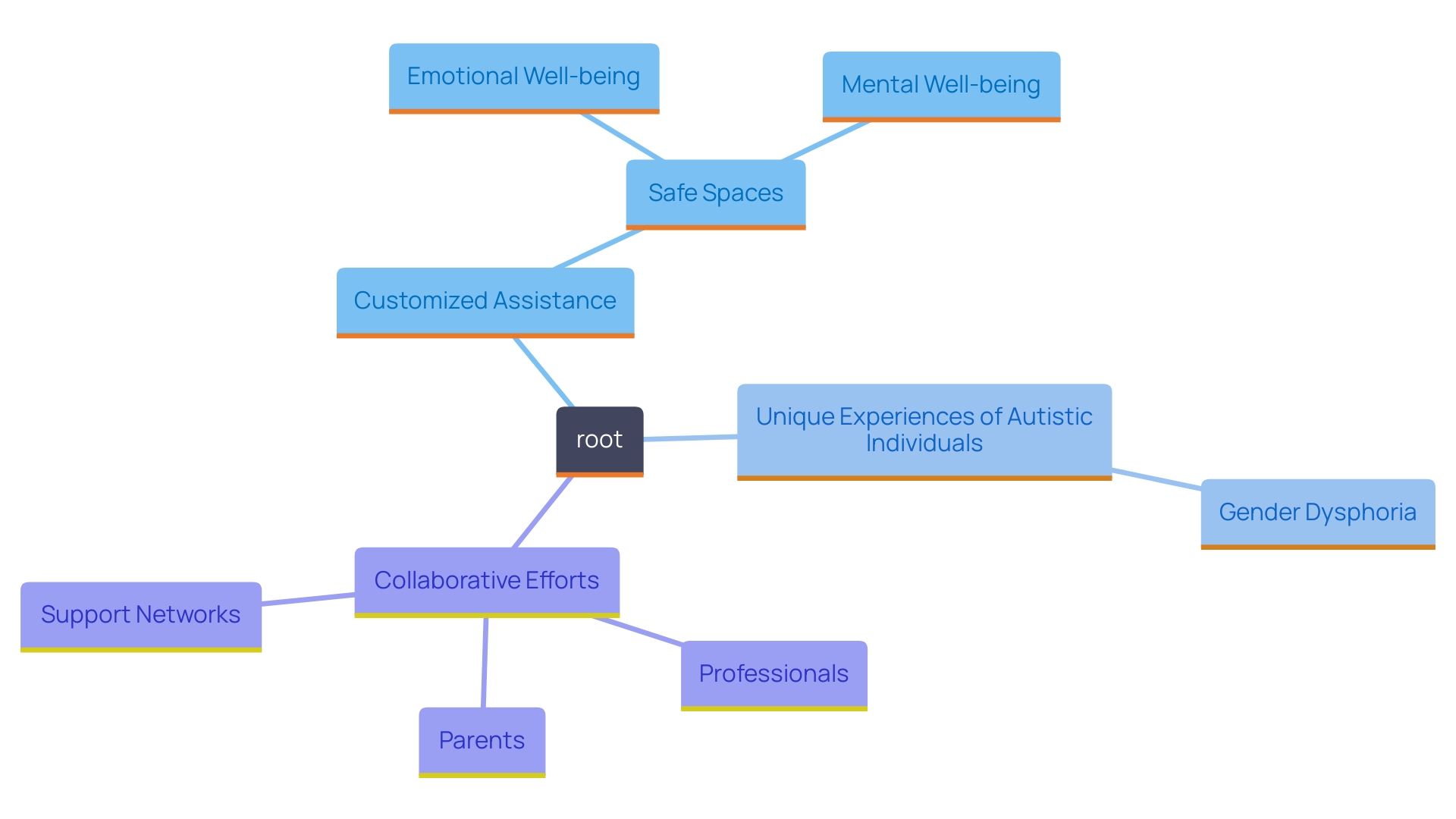
Conclusion
Navigating the intersection of Autism Spectrum Disorder (ASD) and gender dysphoria presents unique challenges that require a nuanced understanding of both identities. As highlighted throughout the article, autistic individuals, particularly those assigned female at birth, often face societal misunderstandings that complicate their experiences of gender identity. The growing recognition of the connection between autism and gender diversity underscores the importance of tailored support systems that can effectively address these complexities.
The data presented indicates a significant prevalence of gender dysphoria among individuals with autism, emphasizing the necessity for support that acknowledges the unique needs of this population. It is essential for parents, caregivers, and advocates to create inclusive environments that not only validate the experiences of autistic individuals but also foster self-advocacy and empowerment. By promoting open communication and understanding, the community can help dismantle stigma and encourage acceptance.
Ultimately, the journey toward understanding and supporting autistic individuals experiencing gender dysphoria involves collective efforts from families, educators, and healthcare professionals. By prioritizing tailored interventions and fostering safe spaces, the well-being of these individuals can be significantly enhanced. Embracing neurodiversity as an integral part of identity is crucial, paving the way for a more inclusive society that respects and celebrates the diverse experiences of all individuals navigating the complexities of gender and neurodiversity.




